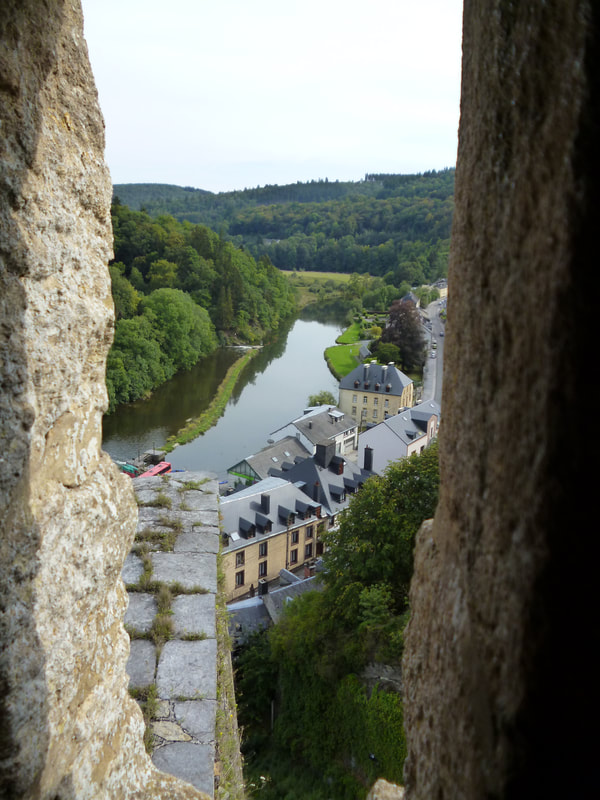Bouillon |
vertical divider
Miasto w południowo-wschodniej Belgii, nad rzeką Semois, w Ardenach, w prowincji Luksemburg. Z racji swojego położenia zwane perłą doliny Semois. Tym, co przyciąga niezmiennie rzesze turystów w te okolice, jest bez wątpienia mroczny, średniowieczny zamek. Chociaż pierwsza wzmianka o mieście pojawiła się w 988 roku, to nie ma wątpliwości, iż Bouillon istniało wieki przed tą datą.
|
The Dukes of the House of Ardenne (Godfryd was the fifth and last in this line) owned the castle until 1096 when Godfryd of Bouillon sold his entire principality to Bishop Liege Otbert. Godfryd of Bouillon was a member of the First Crusade. He won Jerusalem and the title of Protector of the Holy Sepulcher. He was denied the right to wear the royal crown and died in the Holy Land in 1100.
Bouillon pozostało w posiadaniu księcia-biskupa Liege przez blisko sześć stuleci. Na początku XVI wieku musiał się on podzielić władzą z możną rodziną La Marc. W 1678 roku wojska króla Francji Louis'a XIV, po dwudziestodniowym oblężeniu, zdobyły zamek. Miasto, zamek i księstwo zostały przekazane rodzinie La Tour d'Averagne. 26 Octoberdziernika 1795 roku nastąpiło włączenie Bouillon w skład Republiki Francuskiej. Po klęsce Napoleona pod Waterloo, na mocy II Traktatu Paryskiego, Bouillon zostało przyłączone do Holandii, a po uzyskaniu przez Belgię, w 1830 roku, niepodległości stało się częścią nowo powstałego państwa belgijskiego.
Castle bouillon
The greatest and the most recognizable treasure Bouillon. It is a witness of history existing in this place for over a thousand years. Over the centuries changed owners, and the most famous was Godfrey of Bouillon, a participant of the First Crusade to the Holy Land. Z powodu braku historycznych dokumentów trudno dzisiaj ustalić dokładną datę powstania zamku. Pewne jest natomiast to, że zbudowano go do ochrony północno-południowego pasażu pomiędzy dolną i górną Lotaryngią.
This magnificent feudal castle is an example of a building consisting of several independent parts that could defend themselves on their own, but their goal was the idea of common defense. It is part of the canon of military architecture, which says that each subsequent element of a defensive structure must be higher than the preceding one. There are many loopholes in the wall, one above the other. This made it possible to fire in different directions.
The greatest changes in the castle were made by Vauban who came here by order of King Louis XIV. This great architect noticed the great defensive capabilities of the castle. There are three sections here. The first two are the smallest. Additionally, they were reinforced with a defensive wall filled with arrowslits. The last, southern section is the largest and most powerful. It was also strengthened by Vauban, who ordered the construction of defensive walls filled with arrowslits. They allowed fire only in three directions: 45 degrees to the left, straight ahead and 45 degrees to the right. However, they provided incredible protection for the defenders of the castle. Also the semicircular tower in this wall is the work of Vauban. He also created a circular gunpowder tower with a cannon on the roof.
The highest point of the castle is the Austrian tower, converted into an artillery tower by the prince-bishop of Liege George of Austria in 1551. It had arrowslits on each side. Originally, the Austrian tower was a shelter for shooters from enemy fire. Below the Austrian tower there were two cannon batteries that could fire the entire valley between them.
W XIX wieku, w okresie, kiedy rządzili tu Holendrzy, dokonali oni kilku zmian. Wyburzyli wieżę główną, kaplicę i dom zarządcy, dobudowali natomiast kilka baraków i arsenał. Od połowy XIX wieku zamek w Bouillon zaczął popadać w ruinę. Na szczęście stał się atrakcją turystyczna i dziś można go podziwiać za niewielką opłatą. Do zamku wchodzi się przez trzy bramy-mosty, łączące ze sobą trzy niezależne części zamku.
Inside the castle are available, among others, dungeons where we can see tools of torture, as well as weapons and costumes of the castle defenders. A great attraction is the Godfryd Hall, carved in the rock. In its floor there is a wooden cross with sculptures depicting the history of the castle. In summer, in the courtyard, you can see the breeding of birds of the local falconer (eagles, hawks, falcons and African vultures).
|
Address:
Château Fort
Esplanade Godefroid 1 6830 Bouillon |
Opening hours:
Holidays: 10.00-18.30,
Last admission 45 minutes before closing. |
Ticket price:
7 euros
|
Po zakończeniu zwiedzania zamku warto udać się do Muzeum Ducal. Mieści się ono na tym samym wzgórzu co zamek. Zebrano tutaj, w dwóch przyległych do siebie budynkach, różne przedmioty związane z krucjatą Godfryda. Stworzono również ekspozycje poświęcone folklorowi oraz historii miasta i regionu.
|
Address:
Musée Ducal 1-3 Rue du Petit, 6830 Bouillon
|
Opening hours:
monday-sunday: 10.00-18.00
from 1 october: 10.00-17.00 |
Ticket price
Adults: 4 Euro
|
Zainteresowani historią Godfryda z Bouillon koniecznie powinni odwiedzić, mieszczące się w starym klasztorze, centrum historyczne Archéoscope Godefroid de Bouillon. Na szczególną uwagę zasługuje audiowizualny pokaz, który przenosi zwiedzających o tysiąc lat wstecz, do czasów I wyprawy krzyżowej do Jeruzalem, dowodzonej przez Godfryda z Bouillon.
|
Address:
Quai des Saulx 14
6830 Bouillon |
Opening hours:
july-august: 10.00-18.00
rest of the year: info on the museum's website |
Ticket price:
5,5 euros
|
Additional information:
Bouillon to nie tylko wielowiekowa historia, ale także raj dla fanów przyrody czy sportu. Dla nich Semois Kayakas organizuje spływy kajakowe po rzece Semois. Do wyboru są trzygodzinna trasa Bouillon-Poupehan (15 km) lub godzinna Poupehan-Frahan-sur Semois (5 km).
Zakup karty miejskiej, w cenie 11 Euro, umożliwia wstęp do zamku, Archéoscope Godefroid de Bouillon, oraz muzeum Ducal.
Zakup karty miejskiej, w cenie 11 Euro, umożliwia wstęp do zamku, Archéoscope Godefroid de Bouillon, oraz muzeum Ducal.











